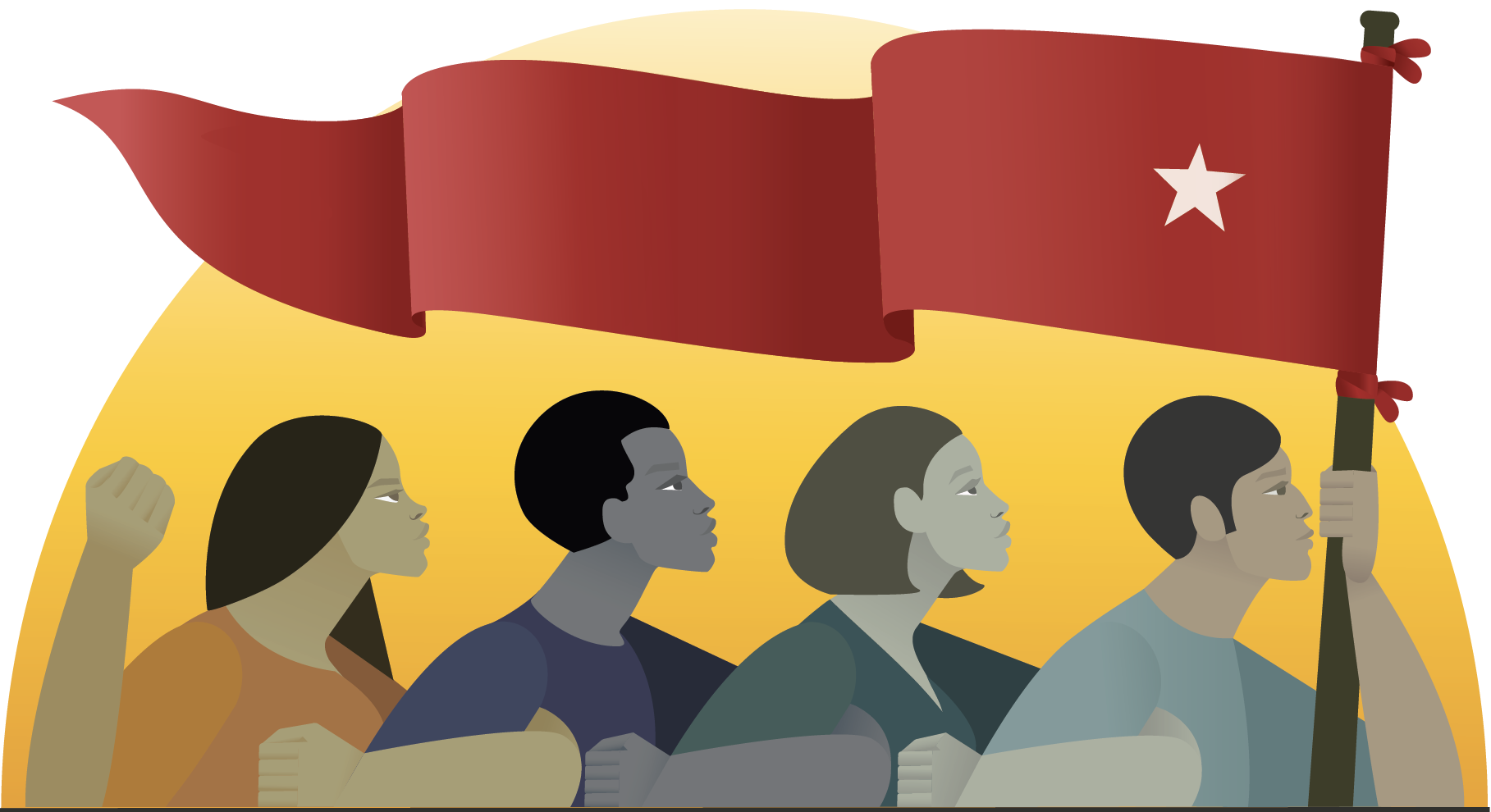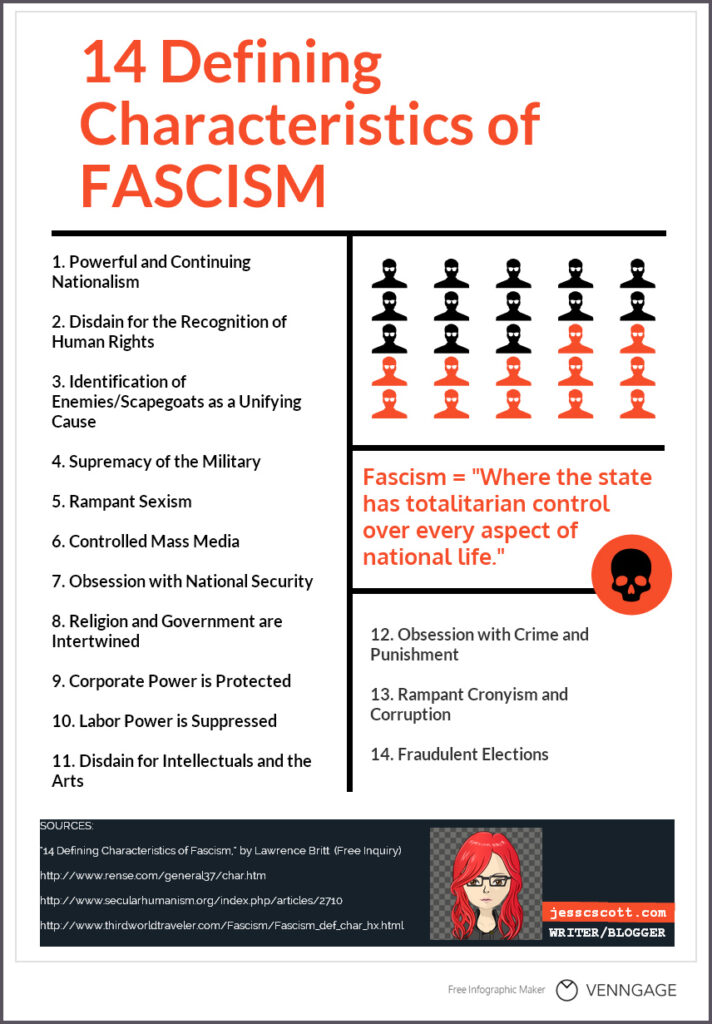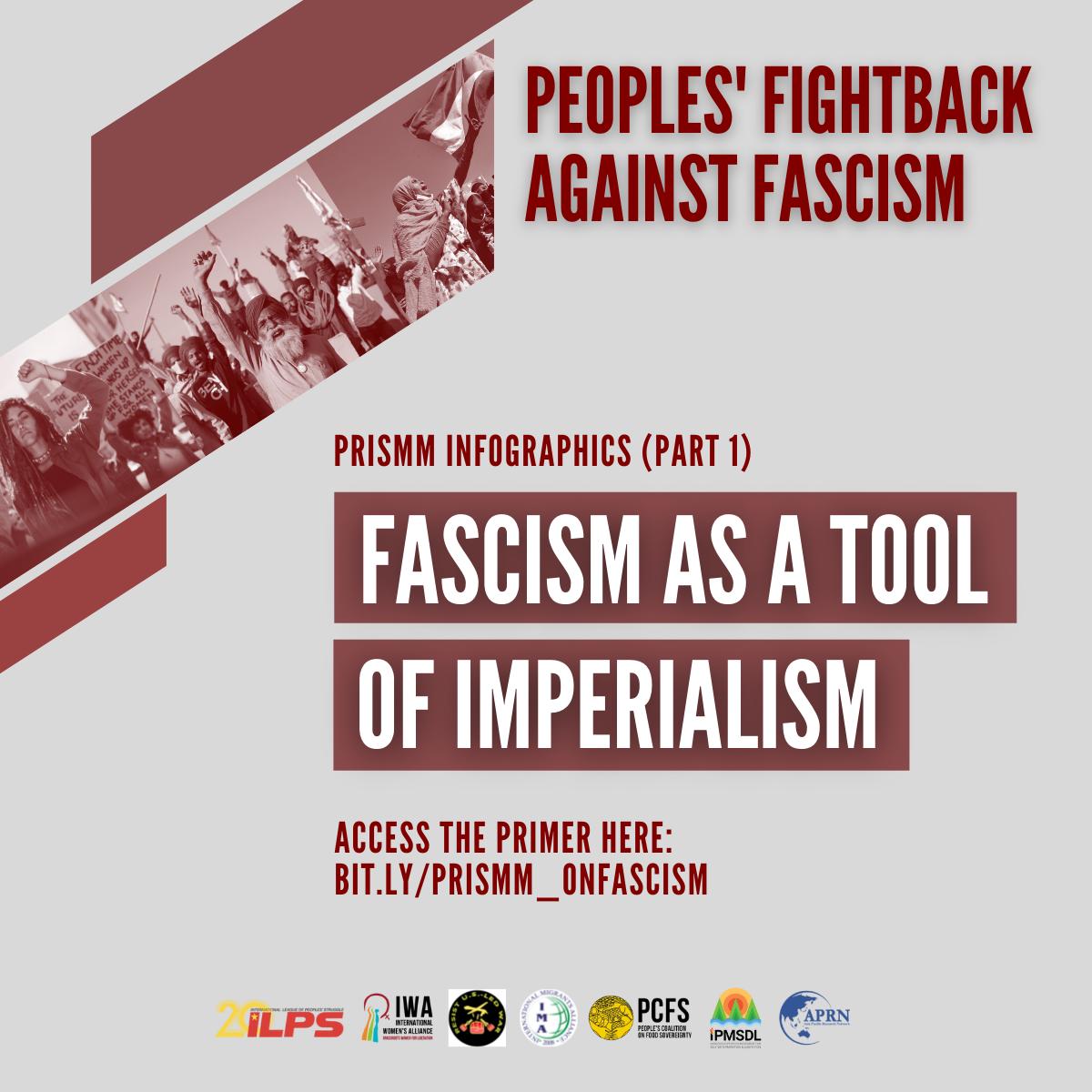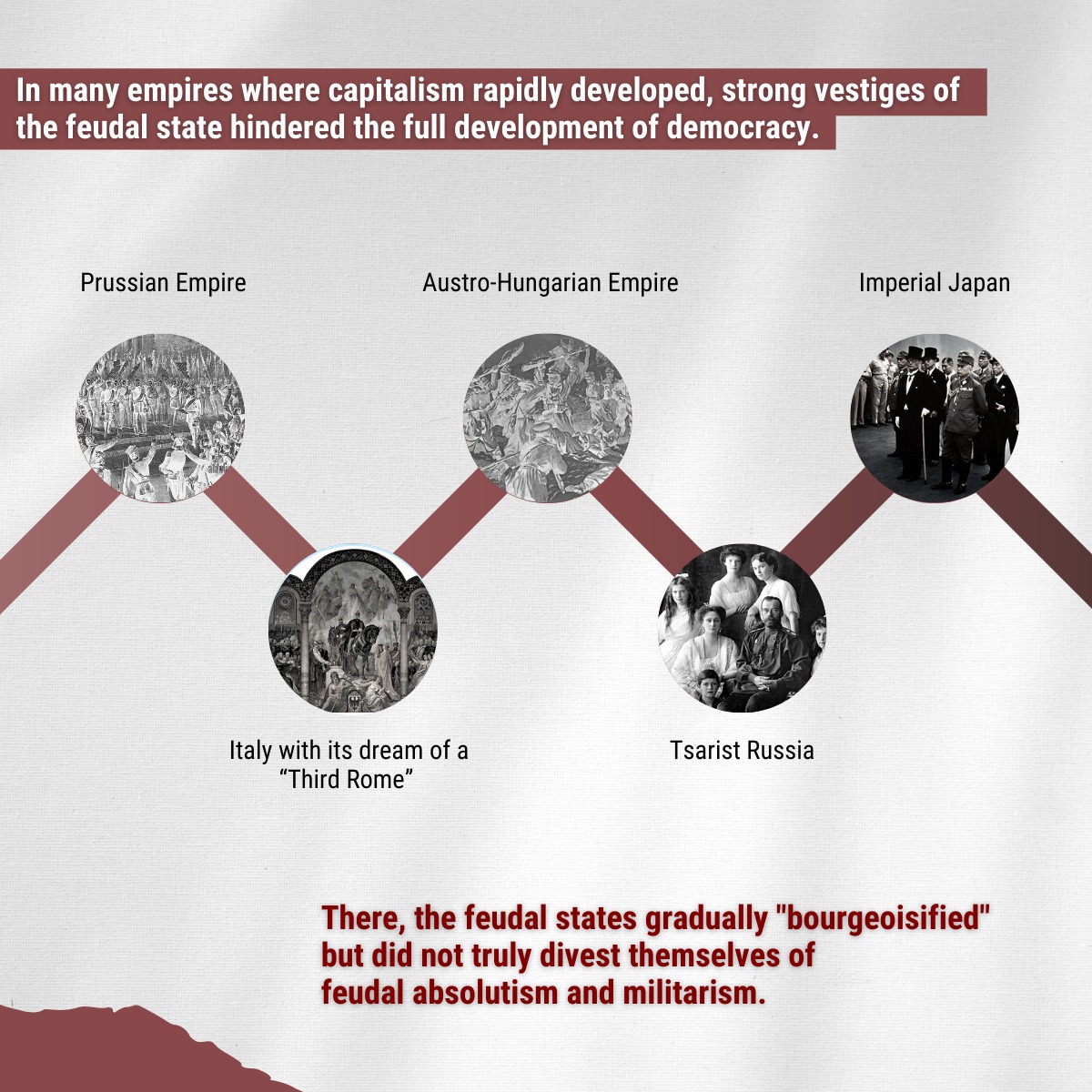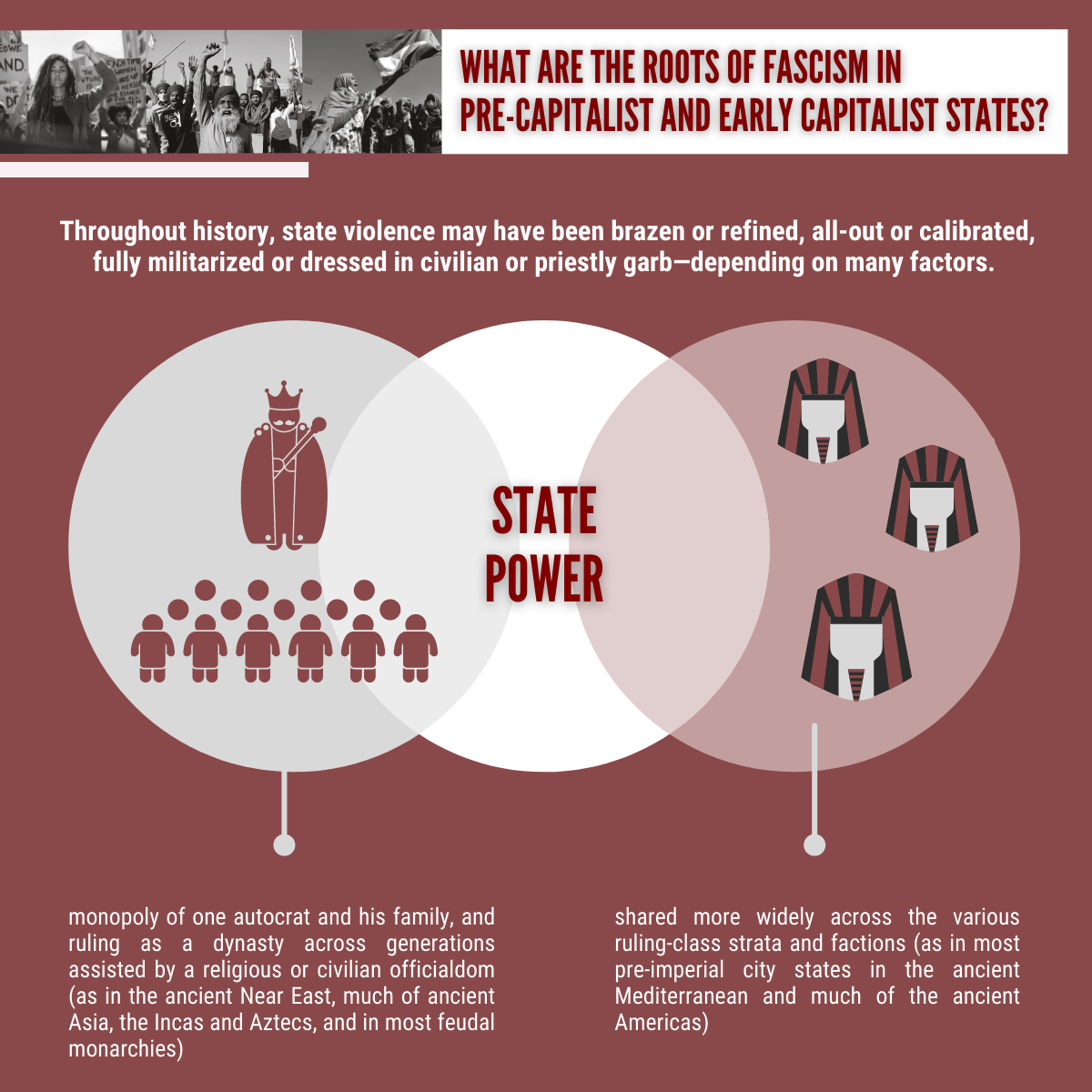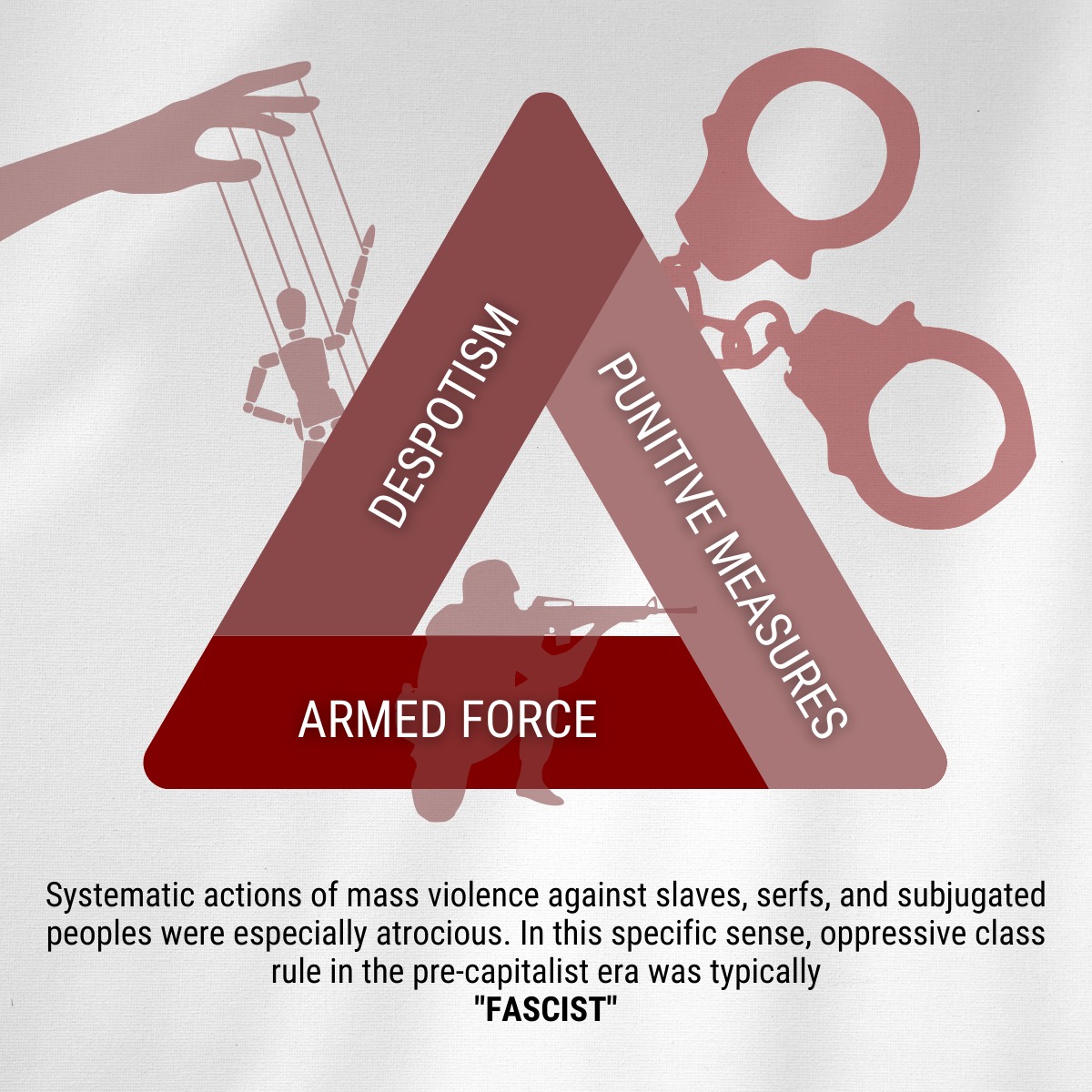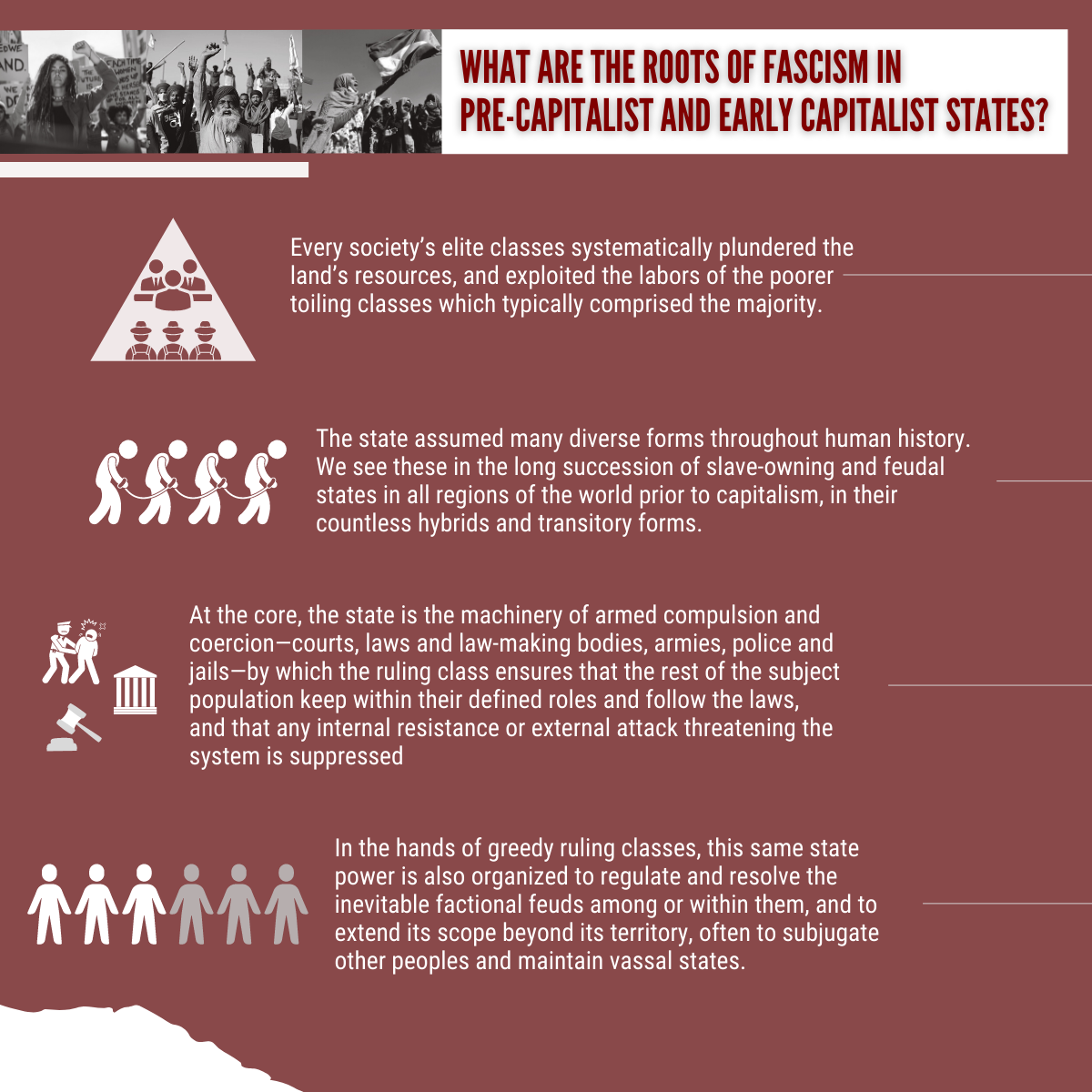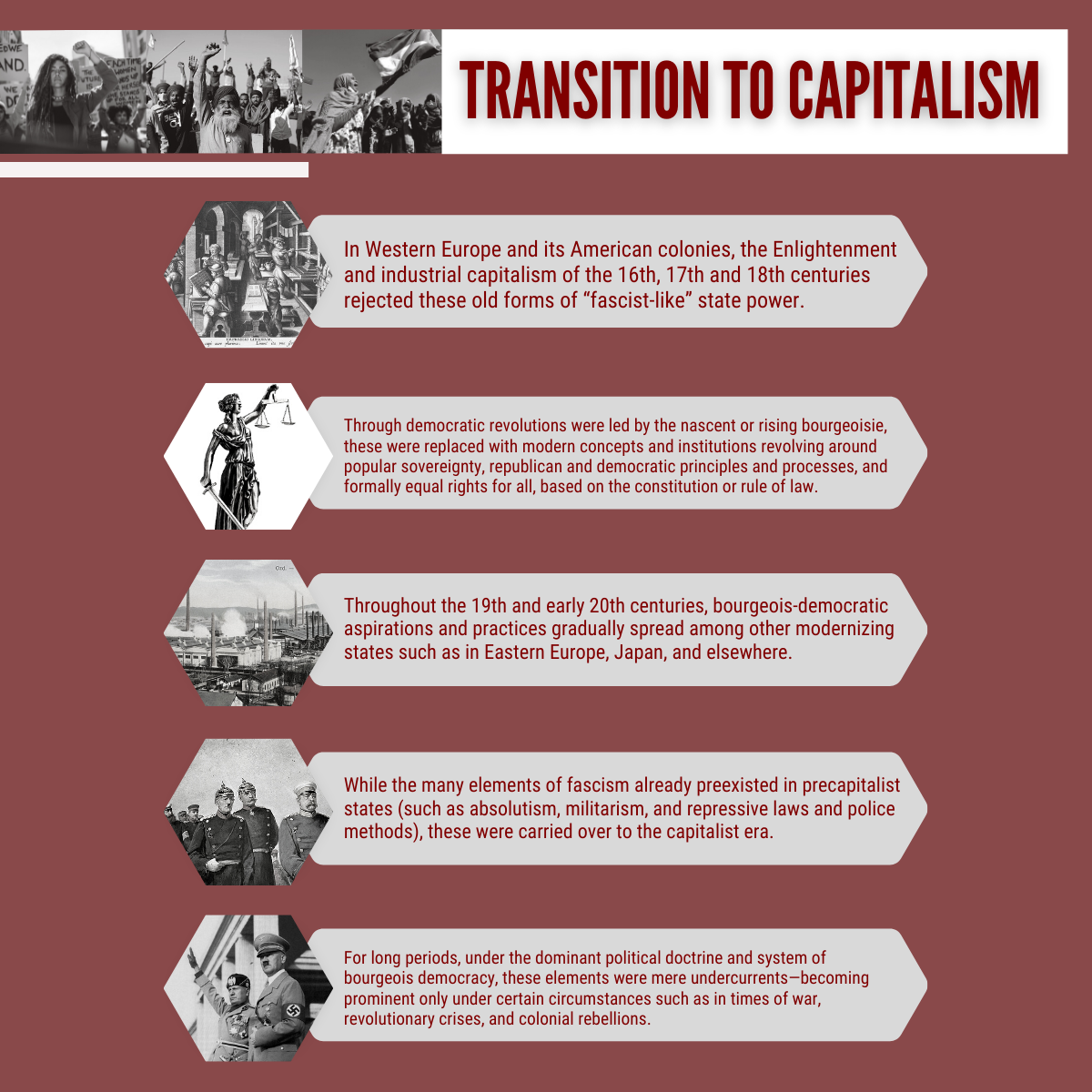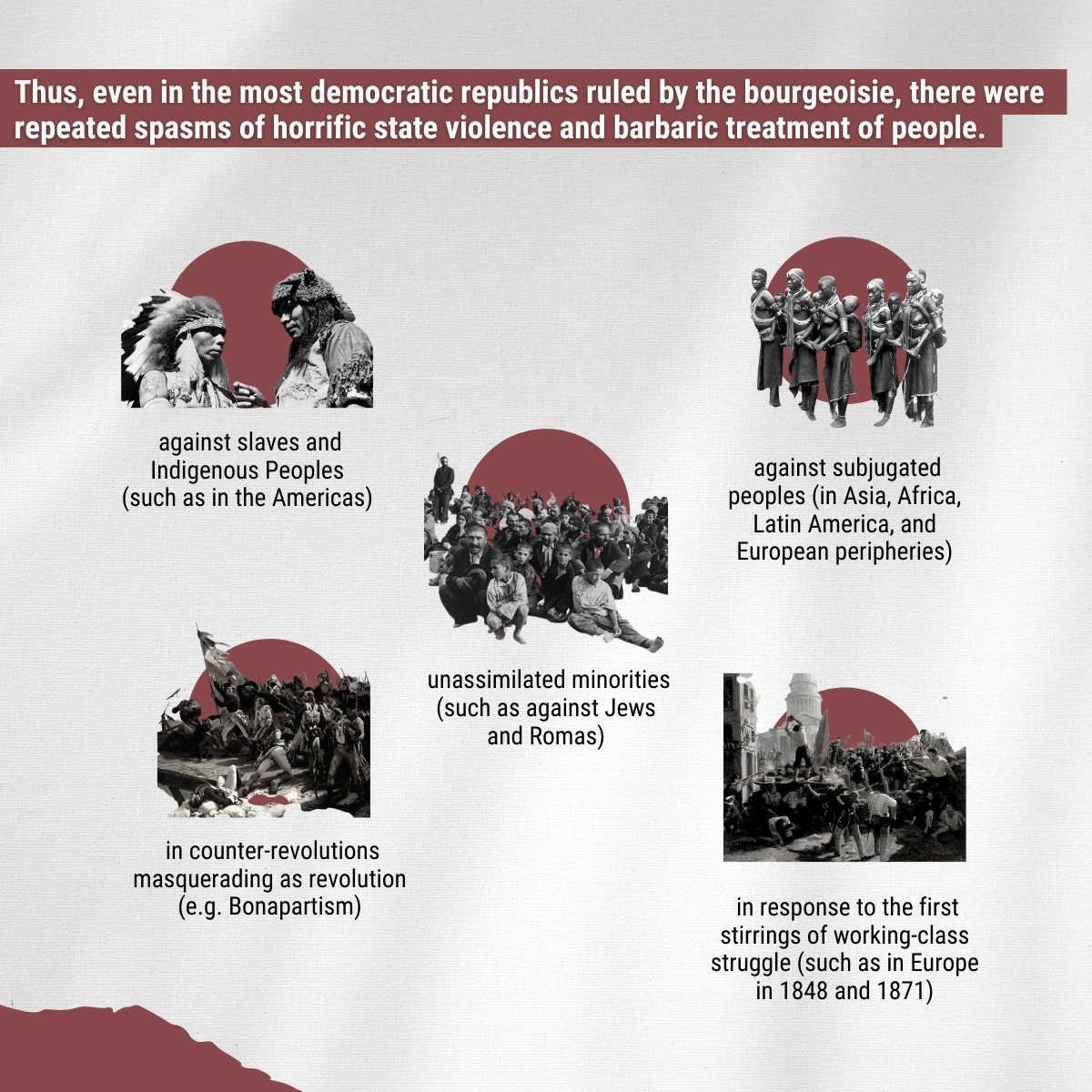PRISM PRIMER | Download PDF »
1. What is fascism?
To fully answer this question will require a discussion of all the main points contained in this primer.
But since we have to start somewhere, we can initially define fascism as the doctrine and practice of (a) a small elite of the big bourgeoisie wielding state power (b) through an extremely centralized political and economic authority that (c) relies mainly and openly on the untrammeled use of armed or coercive force while disposing of formal democratic processes to impose its aims, central of which is (d) to suppress and/or exterminate at all costs its clearly identified enemies, namely, certain other social groups that it considers as existential threats to society, (e) in behalf of the superior nation or race, or some overarching mythical entity.
However, fascism did not just emerge out of nowhere, like full-grown and armed Athena from the forehead of Zeus. Its various elements existed much earlier, and evolved and recombined throughout history. Thus, any discussion of fascism must start with an overview of the state as a whole, how it developed through historical stages, and the processes through which certain groups wielded such power while others were oppressed by it.
2. What are the roots of fascism in pre-capitalist and early capitalist states?
Historically and until now, every state relied on its machineries of coercion. But not every state is fascist.
In the long history of humankind, the earliest or primitive classless communities eventually gave way to other types of societies which were divided into social classes. Every societyʼs elite classes systematically plundered the land’s resources, and exploited the labors of the poorer toiling classes which typically comprised the majority. Such an exploitative and oppressive social system could exist for many generations only by maintaining a state at its very core.
The state assumed many diverse forms throughout human history. We see these in the long succession of slave-owning and feudal states in all regions of the world prior to capitalism, in their countless hybrids and transitory forms. But, in essence, each state is an instrument of violence by which one class continually presses down on another, or at times resolves its own internal conflicts.
As typically taught in university courses on political science, the state has various administrative functions such as tax collection, public works, and the like. But, at the core, it is the machinery of armed compulsion and coercion—courts, laws and law-making bodies, armies, police and jails—by which the ruling class ensures that the rest of the subject population keep within their defined roles and follow the laws, and that any internal resistance or external attack threatening the system is suppressed. In the hands of greedy ruling classes, this same state power is also organized to regulate and resolve the inevitable factional feuds among or within them, and to extend its scope beyond its territory, often to
subjugate other peoples and maintain vassal states.
Throughout history, state violence may have been brazen or refined, all-out or calibrated, fully militarized or dressed in civilian or priestly garb—depending on many factors. State power may have been the monopoly of one autocrat and his family, and ruling as a dynasty across generations assisted by a religious or civilian officialdom (as in the ancient Near East, much of ancient Asia, the Incas and Aztecs, and in most feudal monarchies), or shared more widely across the various ruling-class strata and factions (as in most pre-imperial city states in the ancient Mediterranean and much of the ancient Americas).
As a whole, however, despotism (exercise of absolute power with minimal legalities), armed force and punitive methods were the most dominating and visible features of state power. Systematic actions of mass violence against slaves, serfs, and subjugated peoples were especially atrocious. In this specific sense, oppressive class rule in the pre-capitalist era was typically “fascist.”
Transition to capitalism. In Western Europe and its American colonies, the Enlightenment and industrial capitalism of the 16th, 17th and 18th centuries rejected these old forms of “fascist-like” state power. Through democratic revolutions led by the nascent or rising bourgeoisie, these were replaced with modern concepts and institutions revolving around popular sovereignty, republican and democratic principles and processes, and formally equal rights for all, based on the constitution or rule of law. Throughout the 19th and early 20th centuries, bourgeois-democratic aspirations and practices gradually spread among other modernizing states such as in Eastern Europe, Japan, and elsewhere.
While the many elements of fascism already preexisted in precapitalist states (such as absolutism, militarism, and repressive laws and police methods), these were carried over to the capitalist era. For long periods, under the dominant political doctrine and system of bourgeois democracy, these elements were mere undercurrents—becoming prominent only under certain circumstances such as in times of war, revolutionary crises, and colonial rebellions.
Thus, even in the most democratic republics ruled by the bourgeoisie, there were repeated spasms of horrific state violence and barbaric treatment of people—against slaves and indigenous peoples (such as in the Americas), against subjugated peoples (in Asia, Africa, Latin America, and European peripheries), unassimilated minorities (such as against Jews and Romas), in counter-revolutions masquerading as revolution (e.g. Bonapartism), and in response to the first stirrings of working-class struggle (such as in Europe in 1848 and 1871).
Also, in many empires where capitalism rapidly developed, strong vestiges of the feudal state hindered the full development of democracy. Examples of these were the Prussian and Austro-Hungarian empires (which later evolved into Germany, its claimed territories and smaller states), Italy with its dream of a “Third Rome”, tsarist Russia, and imperial Japan. There, the feudal states gradually bourgeoisified but did not truly divest themselves of feudal absolutism and militarism.
3. How did fascism emerge and rise to extreme prominence under modern imperialism? (review of 1880s-1980s)
Emergence and rise to power. The rapid and gigantic advances in industry and finance, especially in Europe and North America in the 1880s, 1890s, and early 1900s, gave way to the dominance of monopolies and modern imperialism (monopoly capitalism). The crises inherent in capitalism became more frequent and destructive, leading to more class conflicts, colonial subjugation, and inter-
imperialist wars, as described in Lenin’s works.
Three factors in particular combined to gradually push the undercurrent elements of fascism to the surface and eventually to the forefront during the imperialist era:
∙ within the imperialist homelands, growth of working-class militance and socialist (especially Marxist) influence among the toiling masses, and worsening ruling-class quarrels, which called for restrictive laws to justify use of violence and denial of civil liberties;
∙ the imperialist push for more territories, and the adoption of harsher measures to facilitate colonial plunder and to suppress the resistance of subjugated peoples; and
∙ intensifying inter-imperialist rivalries and growing militarism through the expanded role of modern standing armies, their elite officer corps, and the military-industrial complex.
In other words, the rise of fascism is inseparably tied up with imperialism, inter-imperialist rivalries and militarism, worsening capitalist crises, sharper class struggles, and a powerful working-class movement especially when it wages revolutionary struggles for socialism.
As described by the Third International (Comintern) in 1933, fascism is “the open terrorist dictatorship of the most reactionary, most chauvinistic and most imperialist elements of finance capital.” It is a very distinct mode of existence by the modern bourgeois state in the era of imperialism.
Shortly after World War I, and especially in the face of heightened working-class militancy inspired by the Great October Socialist Revolution and the young Soviet state, explicitly fascist organizations arose first in Italy and then in Germany and elsewhere. Mussolini and Hitler, waving their own anti communist versions of “nationalism and socialism,ˮ built their respective mass followings and armed militias among the demobilized soldiers, lumpen-proletarians, and backward sections of workers and peasants.
Mussoliniʼs Blackshirts quickly became armed thugs of the Italian big bourgeoisie, attacking the postwar mass struggles of workers and peasants. This was soon followed by Hitler, whose own Nazi Party and Brownshirts militia played the same role for the German big bourgeoisie.
The fascists took advantage of post-World War I economic troubles, social unrest, and the “specter of Bolshevism” to take power in behalf of their respective big bourgeoisies—Mussolini becoming “Il Duce” after his March on Rome in 1922, and Hitler becoming “Der Fuehrer” after winning Germany’s chancellorship in 1933. In quick succession, full-blown fascist regimes arose in imperial Japan and in the decrepit colonial powers Spain and Portugal. These inspired more fascist parties to proliferate in other countries.
The struggle vs. global fascism in World War II. Under their respective fascist regimes, the German, Italian, and Japanese imperialists rapidly expanded their military strength; launched crusades to reclaim “lost territories” and acquire more colonies; suppressed Communist, trade-union, and democratic opposition; snarled at the Soviet Union and the forces of the Comintern as their ultimate enemy; used ultra-nationalist and “racial-supremacist” propaganda to deceive and divide the masses; and prepared for aggressive war to achieve their imperialist ambitions.
Germany, Italy and Japan, openly scheming as the Axis Powers to redivide the world, met increasing opposition from the other threatened imperialists—the Allied powers led by Great Britain and the US.
On the eve of World War II, the Soviet Union and the Third International (Comintern), its constituent national sections (communist parties), and the vast numbers of worker, peasant, and other mass organizations, likewise built up the global anti-fascist Popular Front to confront the fascist Axis powers.
As World War II spread, the Soviet-led Comintern and Popular Front forces fought against the invading or occupying fascist forces—often side-by-side with US, British, and other Allied forces. The Soviet Union and other communist-led and nationalist-led armies fought the fascists through regular, guerrilla, and urban-partisan warfare, and through all forms of underground mass resistance in occupied areas and open patriotic mass mobilizations in the rear areas. By 1945, the fascist Axis powers were defeated. This signified momentous changes in the global situation.
Fascism and puppet regimes during the Cold War. The next 30 years (1945-1975) saw a much expanded socialist camp, albeit later weakened by revisionism; the dominance followed by gradual decline of US imperialism; the victorious advance of big and small people’s wars, national liberation movements, and independent states in the former colonies; and the Cold War with its waves of anti communist hysteria. All these became favorable factors for fascism to again rear its ugly head worldwide.
Post-World War II imperialism remained the deep well-spring of fascism. The US, while it could still dress up in the liberal garb of bourgeois democracy, absorbed many elements of fascism in its redoubled anti-communist crusades at home and abroad. Not surprisingly, the CIA and the US military industrial complex absorbed into their programs an alarming number of ex-Nazi officials and spies. This was on top of McCarthyite witch-hunts and the FBI’s infamous “Cointelpro” playbook. Similarly, revisionism turned the former socialist states of the Soviet bloc into new breeding grounds of fascism. The Cold War, which became a contest between the two imperialist superpowers, sharply honed the taste for fascism on both sides.
US imperialism was mainly instrumental in the global spread of postwar fascism through its many wars of aggression and other forms of militarist intervention. The most prominent and brutal form of US instigated fascism throughout the Cold War up to the early 1980s were the puppet fascist regimes in its neocolonies, propped up by the CIA, Pentagon, State Department and other US agencies.
These fascist puppet autocracies and military juntas were installed through direct military intervention to stop the march to victory of people’s wars of liberation (as in Korea and Indochina), and through US-instigated power grabs (as in many countries of Latin America, Africa and the Middle East, and in Iran, Pakistan, Indonesia, Philippines, and Thailand). A few were long-standing fascist regimes that enjoyed steady US support for decades (as in Somoza’s Nicaragua and Chiang’s Taiwan).
Throughout the 1950s-1970s, such puppet fascist dictatorships helped US imperialism better protect its big-business interests and military bases, provide cannon fodder for its many interventionist wars, and generally keep its neocolonies under control, especially in periods when liberal-democratic pretensions could no longer stem the tide of armed revolution and national liberation movements.
In the same period, there were also sustained fascist trends or undercurrents in militarist Japan (the US junior partner in Asia), Zionist Israel (the imperialist-backed police-state in the Middle East), brutal British rule in Northern Ireland, and in other countries such as South Africa’s White apartheid regime, the Greek military junta of 1967-74, and the doddering fascist dictatorships in Franco’s Spain and Salazar’s Portugal. Clerico-fascism, which was centered in Italy, Spain and Portugal, could extend its
tentacles to other Catholic-dominant countries for a time, until radical priests and nuns countered it with their Theology of Liberation.
Other forms of fascism. Meanwhile, another distinct taproot of fascism fast sprouted in the Soviet bloc countries ruled by revisionist regimes, and later in post-Mao China as well. Fascism, which is most pronounced in imperialist countries, is utterly antagonistic to proletarian-led revolutions and states—which in turn are the fiercest enemies of fascism. Nevertheless, when socialist countries turn revisionist and revert to capitalism, the big bourgeoisie first reemerges atop highly centralized bureaucracies and economies. This becomes fertile ground for “social-fascism”, i.e., fascism masquerading as socialism. This type of fascism—a legacy of Soviet revisionism still seen in today’s Russia—is also being unmasked in China after the Dengist counter-revolution.
Islamic fundamentalism, which has no tradition of liberal democracy, has very different roots from Western fascism (which emerges upon shedding its former liberal-democratic garb). But once Islamic patriarchy merges with bourgeois state power, it also develops some key features of fascism. The crucial factor remains that of imperialism, which encourages the worst feudal-autocratic features of Islamic patriarchy to strengthen the fascist client state (as in Saudi Arabia) and to harness a rabid counter-revolutionary force (as in US-trained and funded jihadists).
4. What are thus the main features of 20th-century fascism and its emergent patterns in the last 30 years (1990-present)?
Based on our review of the history of fascism in the context of modern imperialism, we can summarize below its main features, most of which have been carried over to the 21st century—although we should also be aware of added features that have emerged in recent decades.
Big-bourgeois class character. At first glance, a fascist group appears supra-class, i.e., it insists to be always for the “whole nation” or “one race”, or for “the people” without any clear class distinctions. At times, its initially petty-bourgeois or national-bourgeois leaders can superficially mimic revolutionary forms and assume a fake and narrow anti-capitalist position, to attract the discontented masses and further prove its “populist” credentials. But the fascists’ biggest effort—at first low-profile, then sooner or later all-consuming—is to cultivate ties with the big bourgeoisie, enlisting its full support and eventually being absorbed into its class ranks.
In the extreme case, fascism advocates a high degree of bureaucrat capitalism under some notion of “corporatism” or signboard of fake socialism. The goal is actually to merge state-bureaucrat and private-capitalist ownership and control of industries, so that the highly concentrated will of the ruling classes’ bureaucratic and private-corporate interests are forcibly imposed on the toiling masses.
This is particularly the case when monopoly capitalism develops into bureaucrat monopoly capitalism —as when formerly socialist states revert to the capitalist road—or when the military-industrial complex is so cancerous it converts top civilian, military, financial/corporate officials into a veritable Deep State. But there are also similar cases of ultra-bureaucrat capitalism in the semi-colonies ruled by comprador big bourgeoisies, such as in China under Chiang Kaishek’s Guomindang and Big Four families, Iran under its last Shah (Mohammad Reza Pahlavi), and to a large extent the Philippines and its crony capitalism under Marcos.
Anti-communist ideology and politics. Throughout much of the 20th century until now, fascist movements, parties and regimes served mainly as counterpoint against proletarian-led revolutionary
movements, and against socialist and people’s democratic states from 1917 onward to the 1970s.
They treat the “spectre of communism” (whether real or conjured) as the worst enemy of society, place their anti-communist positions consistently in the forefront, and push the entire big-bourgeois state to adopt their rabid counter-revolutionary agenda. They use anti-communist witch-hunts and Red-tagging to spew hate-filled propaganda and direct violent attacks against the socialist and democratic forces, and against the broader anti-fascist opposition. They can also stage false-flag operations (“black ops”) then blame the communists, and thus justify their power grab and fascist measures.
In the years between 1990 and 2015, anti-communism may have given way to other themes and schemes such as anti-Islamic fundamentalism, anti-terrorism, and neo-conservatism. But with inter imperialist rivalries heating up anew in recent years, Western imperialist powers are once more whipping up “anti-communist” hysteria to turn public opinion not just against genuine revolutionary movements and anti-imperialist states, but also against their main rivals Russia and China, and also to distract people’s attention away from their own imperialist and fascist crimes. In turn, Russia and China have also become imperialist powers with their own distinct fascist crimes and tendencies.
Fascist-maintained mass base. Fascist groups use the superficial forms and slogans of a mass movement to smokescreen their ultra-reactionary character. When the original fascist groups started in the 1920s, they were at first small and tightly knit, often clandestine and conspiratorial. But sooner or later, they use their pseudo-socialist (actually, bourgeois populist) doctrines, and ultra-nationalist or racial-supremacist slogans, symbolisms and rituals, to build a mass following among the backward sections of the people, redirect the people’s grievances to energize fascist goals, and thus preempt or compete with the revolutionaries and progressives.
Reformists and revisionists also do these tricks. But what is distinctive to fascist parties and groups is that they provide the big bourgeoisie with the coercive mercenary muscle of a mass base that absolutely hates revolution and rejects democratic processes. Thus they enjoy big-bourgeois support and, in times of crisis, could get a hefty share of political power and even monopolize it.
In power, they become ultra-centralist bureaucrats, who are divorced from the masses but may maintain fake “mass movements” with finance, resources, and state protection. Such a “mass base” continues to serve as special fascist machinery for dirty tricks against their political rivals and progressives. In backward neocolonies where the national state may be weak, big feudal landlords and paramount tribal chieftains with their own armed following may develop into warlords, serving as provincial base of fascist overlords at the national level.
Militarism and militarized bureaucracy. The most successful fascist groups, even before their rise to power, already project their counter-revolutionary potential by developing their own blindly loyal armed force—often as paramilitaries—into which they attract disgruntled people (especially young jobless men) by means of guns, funds, flashy uniforms, and parades. They maximize the methods of mercenary armies to instill blind loyalty and feudal discipline in the fascist ranks.
When fascist groups rise to power, their first priority is to build their loyalist base (often an elite and highly equipped force) within the army, police and intelligence services, and to militarize the bureaucracy. They infuse the entire state machinery with military and police methods of governance, and erode the liberal-democratic principle and legal guarantees of civilian supremacy.
Absolutism. Even before their rise to power, fascist groups already carry absolutist notions of
leadership, pushing the cult of a “perfect leader,” or the myth of “a man on a white horse” who will become the nation’s savior. The strongest fascist parties, despite their populist pretenses, are ultra centralized and violently opposed to organizational democracy as well as political democracy. They harp on the weaknesses and unpopularity of a corrupt civilian government and indecisive parliament, in order to put themselves up as the only alternative.
Backed by the big bourgeoisie at a time of extreme crisis, a fascist cabal may successfully seize power through political paralysis, rigged elections, or barefaced military coup, and thus establish a fascist dictatorship. At the top of such a dictatorial regime is a small ruling clique composed of the autocrat or military junta, their closest advisors and officials, probably including the autocrat’s family or close relatives.
From this small but powerful clique would emanate a constant flow of orders, decrees, and other policy (or even judicial) decisions to be enforced as laws of the land. Typically, the regime would try to maintain a democratic facade via rigged elections, a rubber-stamp parliament, military tribunals, and tightly controlled mass media. However, neither effective parliamentary or judicial oversight nor genuine electoral exercises will be offered to undo the fascist regime’s measures—unless the people rise up to force the issue.
Open terrorist rule to suppress democratic rights and opposition. Fascists are openly, actively, and violently anti-democratic from the get-go—with their paramilitaries and thugs attacking mass protests, workers’ strikes, peasant struggles, and individuals and groups linked to the democratic opposition. They demonize their targets through incessant propaganda, and assist state security forces in other ways such as intelligence and black ops.
Upon seizing absolute power as a dictatorship, the fascist ruling clique’s very first steps are to institute an open rule of terror to suppress any criticism or opposition. It will issue orders and decrees that declare and implement martial law or state of emergency; suspend the bill of rights and other constitutional guarantees, especially the democratic rights to assembly, free speech, self-organization, and strike; and shut down or tightly control parliament, regular courts, and the mass media.
In line with its suppression campaigns, the fascist regime will launch relentless waves of mass arrests and raids; throw into jail or torture in safehouses (with no charges or on the flimsiest suspicion) oppositionist leaders and activists, including their families and staff; secretly murder or “disappear” those it deems most troublesome; arbitrarily close offices and seize properties; implement wholesale massacres, bombing, arson, lockdowns or “strategic hamlets,” food blockades, and other types of mass reprisals on top of regular combat operations, especially in localities where there is armed or mass resistance.
Other backward and reactionary social trends. Fascism, in both its doctrines and social behaviors, is closely allied and tends to merge with other trends representing the most backward and reactionary sections of society. These include (1) ultra-nationalism and chauvinism, which counterpose one’s nation or ethnic group as having superior interests and rights against other nations or ethnic groups; (2) xenophobia, which automatically treats with suspicion and hostility other people who don’t belong to one’s nation or ethnic group; (3) racism, which grossly bloats up minor physical traits (such as skin color or type of hair) that don’t signify real or relevant distinctions of ancestry, and turns them instead into false measures of superiority and inferiority; (4) patriarchalism based on notions of “male superiority” and inferiority of non-male genders; and (5) religious persecution that often accompanies ultra-nationalism, chauvinism, xenophobia, and racism.
Ethnic (nationality, indigenous, cultural, religious, and “racial”) minorities, women and non-binary genders, and children are the most vulnerable targets of such backward and reactionary trends— especially because there are material incentives for monopoly capitalists to super-exploit these minorities, women and children.
Fascist tyrants further encourage and ride on these trends to privilege certain sections of the population deemed “superior”, to dehumanize and demonize other sections deemed “inferior,” whip up a non-class smokescreen to hide its real class character, and thus deflect mass outrage. They are able to create scapegoats, making it acceptable to additionally oppress certain sections of the people through hate speech, discriminatory practices, armed attacks or pogroms, plunder of resources and further marginalization amounting to genocide or ethnocide.
All-out propaganda. Regimes with fascist mindets also exert the utmost effort to maximize all the repulsive tricks in the propaganda playbook as practiced in Nazi Germany and updated in the Cold War and post-Cold War programs of the CIA, Pentagon, FBI, and the KGB as well. These include a vast diversity of disinformation tactics, including censorship, outright lies, blackmail, false-flag operations, and other tricks popularized as “Cointelpro.”
In the field of culture, they tirelessly justify fascist ideology and politics through distorted theories of ethics and morality, mythologized “history,” and falsified science. In earlier generations, the clerico fascists used their own propaganda playbook, as epitomized by the Opus Dei and methods dating back to the Inquisition. Today, the phenomenal expansion and monopoly-capitalist control over digital mass media, the Internet, and technologies for artificial intelligence, virtual reality and deep-fakes, have multiplied a thousand-fold the extent and impacts of imperialist-fascist propaganda.
5. How is fascism related to the many urgent issues today?
The global capitalist system continues to be relentlessly tossed by severe crisis, while all the main contradictions of the world are intensifying. So many urgent issues are today interlinked with fascism in various ways, and with the underlying imperialist system as well.
Economic, financial, environmental, and social crises. The 2008 financial meltdown produced a Great Recession, which further worsened into a global depression comparable to the 1930s depression. In the most recent shockwave, the Covid pandemic triggered massive and recurrent lockdowns affecting nearly half of the world, in terms of deeper levels of poverty, unemployment, business closures, and indebtedness. These crises exacerbate so many social inequalities, where only a small elite of financial oligarchies squeeze the labors and livelihoods of the rest of the world (the 99%), plunder its remaining resources, and destroy the planetary environment.
Mass unrest and mass movements for systemic change are spreading in countries rocked by the global and domestic crises. Increasingly, the imperialist states, their financial oligarchies, and their client states can no longer rule in the old way using liberal-bourgeois processes. Their ruling classes are splintering into quarrelsome factions, with some of them pushing more aggressively for fascist and dictatorial solutions.
In many countries, state measures restricting or surveilling people’s movements imposed during the Covid lockdowns—such as bans on mass protests and other public gatherings, mandates for multi function ID cards, and media censorship—have not been lifted or even expanded. These, in turn, are
being met with mass protests and “freedom convoys” that raise legitimate demands in defense of the constitutional bill of rights.
The Covid-related crises of these past two years have opened up vastly new opportunities for the biggest monopoly-capitalist giants (particularly in Big Tech and Big Biotech/Pharma, backed by the financial elites) to expand their global operations and supply chains, squeeze more superprofits, and tighten their hold within imperialist states and international governance bodies.
The deep fascist links and interlocking ties among such shadowy groups of the financial oligarchy which zoomed skyhigh in recent years, such as Blackrock, Vanguard, State Street, Morgan Chase, the Rothschilds, the Gates Foundation and the World Economic Forum, have caused alarm not just among progressive and libertarian movements but also among smaller business groups and governments.
Imperialism as today’s main source of fascism. All imperialist powers continue to pursue state terrorism and wars of aggression against the world’s peoples, on top of worsening inter-imperialist rivalries. The imperialist homelands are wracked by internal crises and class struggles, which gradually erode liberal-democratic formalities and sharpen the political in-fighting among elitist factions. All these trends encourage the growth of militarism, absolutist tendencies, and other elements of fascism.
After the US got mired in its “endless wars on terror” from 2001 onward, new inter-imperialist rivalries emerged and escalated. The rivalry between the traditional imperialist powers (US, Europe, Japan etc.) and the two rising imperialist powers (Russia and China) is becoming especially fierce. All these powers are feverishly engaged in arms buildup, including the capacity for cyberwar, space-based and undersea warfare, and covert operations involving remote-operated drones, mercenaries, and false-flag forces composed of jihadist groups or fascist militia. The case of the US supporting ISIS-linked groups in Syria and Libya, and neo-Nazi militia such as the Azov regiment in Ukraine, clearly proves the tangled links between imperialist meddling and fascist armed groups.
The multipolar character of today’s geopolitics provides even more flashpoints of inter-imperialist rivalries, proxy wars, wars of aggression, escalation of the arms race, and growth of fascism. The standoff between Russia and US-led NATO over Ukraine is just the latest in a series of military muscle flexing and saber-rattling among the imperialist powers. Apart from Europe, the Middle East and Central Asia—which have hugged the headlines in recent years—other flashpoints bear close watching in East and Southeast Asia, South Asia, Africa, and Latin America.
The evolving imperialist narratives to justify fascism. Throughout the Cold War decades (1950s 1980s), the US-led imperialist camp harped on “anti-communism” to justify its militarist and fascistic methods. When the Soviet Union collapsed in 1991, the US proceeded to use NATO to tighten the noose around Russia and to fill the power vacuum in the surrounding regions of the Middle East, the Balkans and Central Asia.
The US-led camp paraded its next lineup of global villains (“rogue states” or “Axis of Evil”), targeting mainly North Korea, Iran, and Iraq for “regime change”, and at certain times including Nicaragua, Cuba, Libya, and Yugoslavia or Serbia. It presented itself as the world’s champion of “human freedoms” while the villains were “inhumane tyrants.” Up to now, it continues to use similar tags of “totalitarianism”, combined with “the threat of nuclear rogues”, to demonize and strangle small states with anti-imperialist policies and socialist aspirations such as North Korea, Cuba, and Venezuela.
But right after the dust settled on the 9/11 attacks in 2001, the US-led coalition launched a new global
crusade against the supposed threat of “terrorism” by Islamic jihadists. The US had in fact created and used these jijadist groups earlier in the 1980s-90s to do its bidding in Afghanistan and other parts of Asia and the Middle East, only to later set them up as villains. The US then turned them into a convenient excuse for its expanded wars of aggression abroad, and for renewed fascist repression at home under the signboard of “homeland security”. The other powers (including Russia and China) and their allies followed suit, bloating up similar “terrorist threats” to justify their own fascist campaigns against revolutionary and resistance movements within their respective spheres of control and influence.
US imperialism has continued to pursue its neo-conservative policy of expanding its sphere of influence and dominating all continents through “endless wars” as described in the Bush-era “Project for the New American Century,” which extended to the Obama era and early Trump years. Now there are proposals to revive Eisenhower’s Cold-War era strategy of confronting if not strangling Russia and China.
At the same time, the US has learned to combine its aggressive wars with non-military modes, such as “color revolutions,” economic sanctions and sabotage, and use of border disputes, to soften target governments or demonize them before they are taken down in a “soft coup” shielded by mass protests. This flanking approach, which the US used repeatedly in post-Soviet Georgia and Ukraine, Brazil, Venezuela (unsuccessful thus far), and China (also unsuccessful thus far), is yet another reminder that imperialists are clever enough to set up their enemies as “brutal fascist regimes” and dress up their overthrow as “popular uprisings” and “revolutions”.
The role of high-tech in the growth of militarism and fascism. High-tech plays a role secondary to the economic, political, military, and other social factors for the growth of imperialist militarism and fascism. Nevertheless, this role is rapidly expanding and its impacts becoming more felt in specific areas of concern.
Nuclear arms, which has pushed the imperialist capacity for war way beyond ultimate human scales, is a huge challenge for world’s peoples and anti-imperialist and antiwar movements to also raise the capacity oppose them from the 1950s onwards. In the past few decades, the imperialist capacity to wage war, subjugate peoples, and suppress mass resistance is again multiplied many-fold by huge digital-electronic, biotech, nanotech, and megatech (space and geo-engineering) advances.
Their applications are now seen in a wide range of fields such as new remotely-operated precision weaponry; synthetic biowarfare and biomedical control; cyber-warfare (including online systems for financial and economic control or sabotage); full-spectrum surveillance of entire populations such as those exposed by Edward Snowden; 24/7 propaganda war at global and national scales using online platforms; and tighter control of mass media and calibrated levels of censorship. In recent years, various propaganda wars have been raging even on just the veracity of content and the reliability of sources of information. Both the barrage of fake news and its supposed nemesis, “fact-checking” mechanisms, are being weaponized in the service of tighter fascist control.
All these offer a veritable expanded arsenal for militarist-fascist states, for use not just against their imperialist rivals and other states, but also against their own peoples and resistance movements. These must thus be urgently confronted by the world’s anti-imperialist and democratic forces.
Caveat for anti-imperialist and democratic activists. We have elaborated in this primer the main features of fascism as a tool of imperialism and as a major threat to the people’s democratic rights and
struggles. As activists, nevertheless, we must apply the principles of class analysis and social investigation of concrete conditions, in order to better understand the political positions and behaviors of particular organizations, groups, and individuals around the issue of fascism. This requires serious study, which in turn should guide the strategy and tactics of the anti-imperialist and democratic movements in our respective countries as they unfold.
While fascist groups and movements have very distinctive features, we must remind ourselves that they are able to influence, recruit and deceive middle and backward sections of the democratic classes— sometimes in big numbers—because of their ability to mimic (in distorted form) some features of the truly progressive and democratic movements. In many countries, mass media and schools have become so infused with ultra-reactionary and anti-communist thinking, that wherever progressive and democratic forces are weak, spontaneous sections of the masses become easy prey to fascist propaganda and recruitment.
We have already mentioned about the imperialist state’s tactic of posing as “anti-fascist” (or even Left) to hide its real fascism and inherent Rightist positions. In doing so, it can justify its attacks against its enemies who are tagged as “fascist,” “terrorist” or “Rightist”—even when these are real Leftists, democrats or antifascists, or in some cases, other imperialists and reactionaries who are on the opposite side of the fence.
6. How should the world’s peoples defend their rights against fascism and imperialism?
History teaches us that the world’s peoples must consistently resist fascism, and fight imperialism as its main source. We must be vigilant and prepared to defend all our civil liberties and democratic rights, including our collective rights as peoples, against any escalation of fascist attacks and restrictions, especially in the framework of worsening imperialist oppression, plunder, and wars of aggression.
Every country and global region, every social class or group, and every mass movement and organization, will certainly have to confront their specific conditions and urgent issues, particularly those that affect the broad toiling masses of proletarians, peasants and other semiproletarians, indigenous peoples, women and youth. These issues and demands of the masses, the ongoing political and economic struggles around them, and the various groups that engage them, must be closely documented and studied as they unfold, and projected to gather the widest possible sympathy and solidarity by the rest of the world’s peoples. So many international channels and platforms for coordination are available for these.
The rich experiences of the global people’s struggles in the 20th century also teach us that proletarian led armed revolutions for national liberation, democracy and socialism are the most powerful bulwarks against the monstrous and relentless armed attacks of imperialism and its fascist forces. We must study and learn lessons from shining examples of the Soviet Union and China in World War II and the many national liberation movements thereafter. Each country, political force or party, and mass organization will have to make the necessary preparations and decisions based on their concrete conditions.
At the same time, a broad anti-imperialist and democratic front can arouse, organize and mobilize the people in their tens or hundreds of millions nationwide, to fight imperialism and fascism by all means possible. In the final analysis, only the unity and heroic struggle of all toiling masses, all peoples, and all countries oppressed by imperialism can finally defeat it and eradicate this monstrosity of fascism.
###
